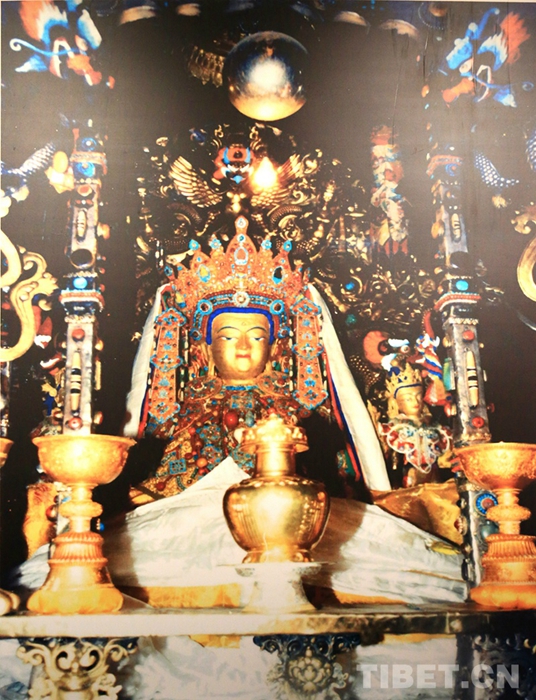Tibetan New Year's day celebration
In ancient Tibet, New Year's Day took place in summer. When the wheat became ripe, a new year began. In Kongbo, eastern Tibet, New Year’s Day took place on the first day of the 10th month of the Tibetan calendar. Kongbo, an area with a long history, emerged long before the rise of the Tubo Kingdom. It was also the place where the Bon religion flourished.
In the 13th century, when Tibet was under the rule of the Sagya Regime, Tibetans began to celebrate New Year's Day on the first day of the first month of the Tibetan calender.
Famers, however, often recognize the first day of the 12th Tibetan month, mainly because it heralds busy spring ploughing.
BUSY PREPARATION.
Prior to the New Year's Day, Tibetan repaint their houses, polish niches for the statue of Buddha and sacrificial objects, and draw white dots on house beams and windows as a token of longevity and bumper harvest.
Kitchen walls are painted with scorpion is the incarnation of the daughter of the dragon king, or the Kitchen God.
In front of the statue of the Buddha are piled fried refreshments, salt, tea sheep head-shaped butter sculptures and fruit. Salt comes from northern Tibet and from east Tibet.
The area in front of the house is sprayed with snow water, and is adorned with a white clay Eight Treasure pattern, or the shapes of gold fish, treasure bottle, marine conch shell and religious wheel.
Before sunset on the 29th day of the 12th Tibetan month, a flour dough family feast is held. Each family inserts nine things into nine pieces of dough including:
□ sheep wool which symbolizes a kind heart;
□ salt which symbolizes laziness;
□ white stone which symbolizes pureness and simplicity;
□ charcoal representing a cruel heart;
□ dried peach for good health;
□ pepper which symbolizes vigor;
□ pea which symbolizes shrewdness; and
□ a tiny monster with small head and big belly which is an invitation to public punishment.
Those who eat the tiny monster will be made to bark like a dog.
GHOST, GET OUT!
Each family builds a pile of stones in the courtyard, where left?overs in battered pots serve as sacrificial food. A ghost may have a good “feast” before it is driven out of the home.
Soon after the ghost has finished its feast, the host kicks the stone pile aside, and, grasping the battered pot, runs away wildly while other family members holding torches run after him. Thus, the street , is filled with running people.
People in Lhasa run to the Chongseikang Square, where they burn piles of highland barley and smash the pots and declare victory in the war against the ghost. In suburban areas of Lhasa, people will bring a white stone back home to show their family members they have driven the ghost away.
Prior to the 1960s, a grand sorcerer's dance was held in the Potala Palace to drive away the ghost.
FIRST VAT OF WATER.
Very few families go to bed on the eve of New Year's Day. In the small hours, the hostess leaves to get the first vat of snow water. It is believed that the Master of the Earth is pouring the milk of the snow lion into the sources of the rivers. Anyone who drinks water with the milk will enjoy longevity and good luck.
The first vat of water is used to worship the Buddha before being used to make butter and tea.
BALLADEERS.
Early in the morning of the New Year’s Day, balladeers wearing a white goatskin mask go from house to house shouting,“God wins!”
Each family swing the door wide open for them to sing auspicious songs. These artists, who were deemed as poor people or beggars in the past, are warmly treated. This is followed by worship of the statue of Sakyamuni in the Jokhang Monastery believed to have been brought to Lhasa some 1,300 years ago by the Tang Dynasty (618-907) Princess Wencheng. There, worshippers add butter into the butter lamps and prostrate themselves at the foot of the statue of Sakyamuni....
DRINKING TO HEART'S CONTENT.
The people of Lhasa have a tradition of not visiting relatives and friends on the New Year’s Day. Instead, holding auspicious containers of wheat and roasted highland barley flour, they take to the street.
When people meet in the street, they taste each other's offerings and then throw them into the air three times as a token of worship to the Heaven, the earth and the rivers. After blessing each other, they propose a toast, cup by cup. No mat?ter whether friends or strangers, they wish happiness to each other while main?taining a tradition of bottoms-up until sunset.
CELEBRATIONS IN THE POTALA PALACE.
The first day of the first Tibetan month is the New Year for the Lamas, with the second day as the New Year for the King.
In the past, celebrations were held in the Potala Palace on the two days. Fried food was piled up high in front for the Dalai Lama. Those who chanced to have a share of this were believed to have luck in the new year.
PLANTING FLAGS IN MOUNTAINS.
On the third day of the first Tibetan month, Lhasa residents climb up on their roofs where they hold a sutra streamers plan?ting ceremony. They go into mountains in groups to plant five-color sutra streamers, with the five colors of white, blue, yel?low, red and green respectively represent?ing clouds, the sky, the earth, the fire and rivers. The streamers are painted with horses surrounded by lions, tigers, drag?ons and roc. Those who plant the sutra streamers at the highest point have the best luck.
The article is written by AINAM.
Tibet Stories

Why did Emperor Qianlong adopt the reincarnation system?
The system of drawing lots from a golden urn to choose the reincarnation of a Living Buddha ...

